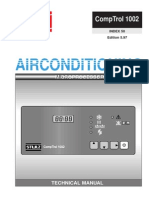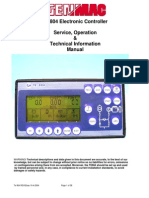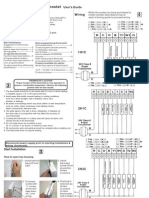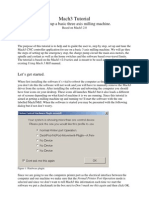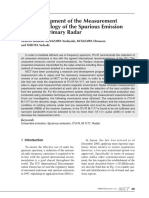0 ratings0% found this document useful (0 votes)
TOL3Dev1 2 PDF
TOL3Dev1 2 PDF
Uploaded by
luislucas13This document provides a quick guide for using the TOL3Dev1_2.xls software for setting calculations. It outlines the basic steps, which include starting the application by enabling macros, selecting the device type, entering basic settings, and calculating trip curves and thermal behavior through cold starts, warm starts, and cycles. The software uses the same algorithms as the TOL3Dev function block to automatically calculate advanced settings and results, and provides plotting and reporting functions.
Copyright:
© All Rights Reserved
Available Formats
Download as PDF, TXT or read online from Scribd
Download as pdf or txt
TOL3Dev1 2 PDF
TOL3Dev1 2 PDF
Uploaded by
luislucas130 ratings0% found this document useful (0 votes)
This document provides a quick guide for using the TOL3Dev1_2.xls software for setting calculations. It outlines the basic steps, which include starting the application by enabling macros, selecting the device type, entering basic settings, and calculating trip curves and thermal behavior through cold starts, warm starts, and cycles. The software uses the same algorithms as the TOL3Dev function block to automatically calculate advanced settings and results, and provides plotting and reporting functions.
Original Title
TOL3Dev1_2.pdf
Copyright
© © All Rights Reserved
Available Formats
PDF, TXT or read online from Scribd
Share this document
Did you find this document useful?
Is this content inappropriate?
This document provides a quick guide for using the TOL3Dev1_2.xls software for setting calculations. It outlines the basic steps, which include starting the application by enabling macros, selecting the device type, entering basic settings, and calculating trip curves and thermal behavior through cold starts, warm starts, and cycles. The software uses the same algorithms as the TOL3Dev function block to automatically calculate advanced settings and results, and provides plotting and reporting functions.
Copyright:
© All Rights Reserved
Available Formats
Download as PDF, TXT or read online from Scribd
Download as pdf or txt
0 ratings0% found this document useful (0 votes)
TOL3Dev1 2 PDF
TOL3Dev1 2 PDF
Uploaded by
luislucas13This document provides a quick guide for using the TOL3Dev1_2.xls software for setting calculations. It outlines the basic steps, which include starting the application by enabling macros, selecting the device type, entering basic settings, and calculating trip curves and thermal behavior through cold starts, warm starts, and cycles. The software uses the same algorithms as the TOL3Dev function block to automatically calculate advanced settings and results, and provides plotting and reporting functions.
Copyright:
© All Rights Reserved
Available Formats
Download as PDF, TXT or read online from Scribd
Download as pdf or txt
You are on page 1/ 7
Quick Guide for the TOL3Dev1_2.
xls setting calculation software
1 Starting the application
The Excel-application TOL3Dev1_2 contains macros. For the correct operation, the
macros must be enabled. Before starting the application check that the security level
in the Excel is set to medium (fig. 1 and 2).
Fig. 1. The security settings can be found form the Tools menu.
Fig. 2. The security level must be set to Medium.
When the application is started (and the security level is set to medium or low) the
Excel informs that the application contains macros (fig. 3). For the correct operation
of the application select Enable Macros.
Fig. 3. Excel informs that the application contains macros.
The start up text will appear and the used is forced to approve the text by clicking OK.
Fig. 4. The start up text.
2 Settings
The default screen is called "Basic settings".
At the bottom of the Basic settings push buttons for all functions can be found.
2.1 Entering basic settings
The Basic settings includes the basic data of the protected device (motor, generator or
transformer) and the Basic settings of the TOL3Dev function block. Enter the values
and notice the unit of measure required by the program.
Place the cursor above the red
corner to see the help text
2.2 Device type
To select the device type press the push button.
2.3 Advanced settings
The idea in the TOL3Dev function block is that after entering or changing any of the
basic settings the function block automatically calculates the advanced settings.
Therefore there is no necessary need to change the advanced settings.
The same idea is used in this calculation program. The program uses the same
algorithm as the function block to calculate the advanced settings automatically. If
needed the advanced settings can be changed by pressing the push-
button.
3 Trip curves
After pressing the push button the co-ordination curves including the start
current and relay trip curves (cold and warm) are plotted. Note that always after
entering the Trip curves the Warm-Relay trip curve is calculated using a default prior
load setting 0.883 x. Therefore if another prior load will be used the value must first
be entered.
4 Cold starts, Warm starts and Cycles
The calculation program can be used to simulate the thermal behaviour.
4.1 Prior load
In the Cold starts the prior load is naturally zero. In the Warm starts the prior load can
be set by the user
At the Cycles the prior load can be done by starting the motor and using enough long
running time.
4.2 Starts/cycles
In Cold and Warm starts the used can define the number of starts, current after start,
the running and stopping time.
In Cycles the used can also define is the motor stopped between the cycles. I.e. if the
motor is not stopped only the load level changes and there is no new start. Naturally if
the stopping time is set the motor should be restarted.
4.3 Calculus and result
The user must press the push-button after any changes to recalculate the
results and to get updated plotting.
By default the plotting has all curves but the user can select any curve not to be
plotted.
There is also an special note field for both the stator and the rotor.
5 Report
The final report can be seen with the button.
You might also like
- SB685-EVOLUTION Service-Tool R2 (IMPORTANTE)No ratings yetSB685-EVOLUTION Service-Tool R2 (IMPORTANTE)33 pages
- Introduction to the simulation of power plants for EBSILON®Professional Version 15From EverandIntroduction to the simulation of power plants for EBSILON®Professional Version 15No ratings yet
- L 120 E 302. Instrument Control Unit I-ECU, Error SymptomNo ratings yetL 120 E 302. Instrument Control Unit I-ECU, Error Symptom56 pages
- SS Brewtech 1V Using Omron E5CC PID Cheat SheetNo ratings yetSS Brewtech 1V Using Omron E5CC PID Cheat Sheet2 pages
- Test Cases: Facebook Login Page: Front-EndNo ratings yetTest Cases: Facebook Login Page: Front-End5 pages
- Service and Operator'S Manual: 3"-4" Isovalve Valve Multistep - /R Dwg.4570-4571100% (2)Service and Operator'S Manual: 3"-4" Isovalve Valve Multistep - /R Dwg.4570-457126 pages
- Additel/Logii Data Logging Software User ManualNo ratings yetAdditel/Logii Data Logging Software User Manual12 pages
- User 'S Manual: Virtual Lab For Basic ElectronicsNo ratings yetUser 'S Manual: Virtual Lab For Basic Electronics24 pages
- RZNC-0501 Users Guide - Rabbit Laser USANo ratings yetRZNC-0501 Users Guide - Rabbit Laser USA28 pages
- Bht 002 Electric Heating Wifi Thermostat ManualNo ratings yetBht 002 Electric Heating Wifi Thermostat Manual12 pages
- EasyStart HomeResidential Installation GuideNo ratings yetEasyStart HomeResidential Installation Guide17 pages
- KPG201C Digital Pressure Gauge With Data Logger ManualNo ratings yetKPG201C Digital Pressure Gauge With Data Logger Manual4 pages
- The Utracer, A Miniature Tube Curve Tracer - TesterNo ratings yetThe Utracer, A Miniature Tube Curve Tracer - Tester39 pages
- E21 Controller Operation Manual - 2023 Latest Version (1)No ratings yetE21 Controller Operation Manual - 2023 Latest Version (1)19 pages
- Computerised Systems Architecture: An embedded systems approachFrom EverandComputerised Systems Architecture: An embedded systems approachNo ratings yet
- Hacks To Crush Plc Program Fast & Efficiently Everytime... : Coding, Simulating & Testing Programmable Logic Controller With ExamplesFrom EverandHacks To Crush Plc Program Fast & Efficiently Everytime... : Coding, Simulating & Testing Programmable Logic Controller With Examples5/5 (1)
- A00 Book EFSchubert Physical Foundations of Solid State Devices100% (1)A00 Book EFSchubert Physical Foundations of Solid State Devices273 pages
- 3-4 Development of The Measurement Technology of The Spurious Emission From Primary RadarNo ratings yet3-4 Development of The Measurement Technology of The Spurious Emission From Primary Radar12 pages
- PLC With PIC16F648A Microcontroller (Part 1) : ELECTRONICS WORLD November 2008No ratings yetPLC With PIC16F648A Microcontroller (Part 1) : ELECTRONICS WORLD November 20088 pages
- LEC # 08 Distribution System Voltage RegulationNo ratings yetLEC # 08 Distribution System Voltage Regulation61 pages
- GT3000 Communication Manual: Answer Drives S.R.L. - Partially Owned by Ansaldo Sistemi Industriali - S.p.ANo ratings yetGT3000 Communication Manual: Answer Drives S.R.L. - Partially Owned by Ansaldo Sistemi Industriali - S.p.A113 pages
- An Evaluation of The HVDC and HVAC Transmission EconomicNo ratings yetAn Evaluation of The HVDC and HVAC Transmission Economic6 pages
- Model PG Cable Connector Installation and Operating ManualNo ratings yetModel PG Cable Connector Installation and Operating Manual6 pages
- Microelectronics Journal: A Low-Power Comparator With A Wide Input VCM RangeNo ratings yetMicroelectronics Journal: A Low-Power Comparator With A Wide Input VCM Range13 pages
- On-Chip High-Voltage Generation in MNOS Integrated Circuits Using An Improved Voltage Multiplier TechniqueNo ratings yetOn-Chip High-Voltage Generation in MNOS Integrated Circuits Using An Improved Voltage Multiplier Technique5 pages
- Data Driven System Engineering: Automotive ECU DevelopmentFrom EverandData Driven System Engineering: Automotive ECU Development
- Introduction to the simulation of power plants for EBSILON®Professional Version 15From EverandIntroduction to the simulation of power plants for EBSILON®Professional Version 15
- L 120 E 302. Instrument Control Unit I-ECU, Error SymptomL 120 E 302. Instrument Control Unit I-ECU, Error Symptom
- Service and Operator'S Manual: 3"-4" Isovalve Valve Multistep - /R Dwg.4570-4571Service and Operator'S Manual: 3"-4" Isovalve Valve Multistep - /R Dwg.4570-4571
- KPG201C Digital Pressure Gauge With Data Logger ManualKPG201C Digital Pressure Gauge With Data Logger Manual
- The Utracer, A Miniature Tube Curve Tracer - TesterThe Utracer, A Miniature Tube Curve Tracer - Tester
- E21 Controller Operation Manual - 2023 Latest Version (1)E21 Controller Operation Manual - 2023 Latest Version (1)
- The Essential Guide to Internet of Things (IoT)From EverandThe Essential Guide to Internet of Things (IoT)
- Ti 84 Plus Calculator: QuickStudy Laminated Reference GuideFrom EverandTi 84 Plus Calculator: QuickStudy Laminated Reference Guide
- Control System: Fundamentals and ApplicationsFrom EverandControl System: Fundamentals and Applications
- Computerised Systems Architecture: An embedded systems approachFrom EverandComputerised Systems Architecture: An embedded systems approach
- Hacks To Crush Plc Program Fast & Efficiently Everytime... : Coding, Simulating & Testing Programmable Logic Controller With ExamplesFrom EverandHacks To Crush Plc Program Fast & Efficiently Everytime... : Coding, Simulating & Testing Programmable Logic Controller With Examples
- A00 Book EFSchubert Physical Foundations of Solid State DevicesA00 Book EFSchubert Physical Foundations of Solid State Devices
- 3-4 Development of The Measurement Technology of The Spurious Emission From Primary Radar3-4 Development of The Measurement Technology of The Spurious Emission From Primary Radar
- PLC With PIC16F648A Microcontroller (Part 1) : ELECTRONICS WORLD November 2008PLC With PIC16F648A Microcontroller (Part 1) : ELECTRONICS WORLD November 2008
- GT3000 Communication Manual: Answer Drives S.R.L. - Partially Owned by Ansaldo Sistemi Industriali - S.p.AGT3000 Communication Manual: Answer Drives S.R.L. - Partially Owned by Ansaldo Sistemi Industriali - S.p.A
- An Evaluation of The HVDC and HVAC Transmission EconomicAn Evaluation of The HVDC and HVAC Transmission Economic
- Model PG Cable Connector Installation and Operating ManualModel PG Cable Connector Installation and Operating Manual
- Microelectronics Journal: A Low-Power Comparator With A Wide Input VCM RangeMicroelectronics Journal: A Low-Power Comparator With A Wide Input VCM Range
- On-Chip High-Voltage Generation in MNOS Integrated Circuits Using An Improved Voltage Multiplier TechniqueOn-Chip High-Voltage Generation in MNOS Integrated Circuits Using An Improved Voltage Multiplier Technique






















